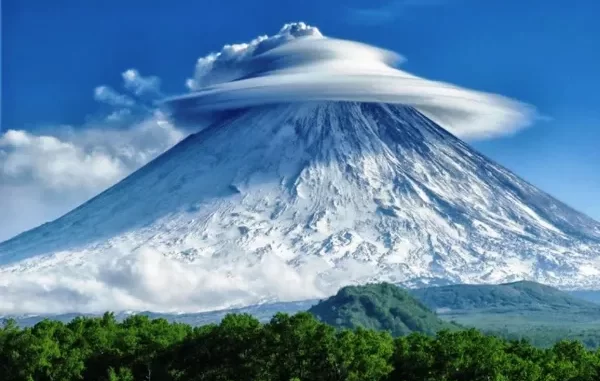
A composite volcano is a type of volcano that is formed by the accumulation of both lava and volcanic ash and rock. This type of volcano is typically found in areas of convergent plate boundaries, and is usually associated with explosive eruptions of high-silica magma.
Composite volcanoes can be found all around the world, including in the United States, Mexico, Central America, South America, and the Pacific Rim. The most famous composite volcano is Mount St. Helens in Washington State. In this article, we will discuss the structure and characteristics of composite volcanoes, as well as their potential to produce devastating eruptions.
How Do Composite Volcanoes Form?
Composite volcanoes, also known as stratovolcanoes, are the most common type of volcano found on Earth. These volcanoes form from a combination of several different processes, most often involving the eruption of lava and ash from the magma chamber beneath the surface.
The formation of composite volcanoes begins with a subduction zone, where two tectonic plates collide and one plate slides beneath the other. As the one plate moves further into the mantle, high levels of pressure force molten rock, known as magma, up from the mantle.
The magma pushes up through the Earth’s crust and erupts from the surface in the form of lava and ash. Once the magma reaches the surface, it begins to cool and harden. As it cools, it forms layers of ash, rock, and other volcanic material, which add to the height of the volcano.
Over time, these layers accumulate and form a large cone shape, as the magma continues to erupt from the vent at the top. As the volcano grows, so does the pressure inside the magma chamber, leading to more frequent and larger eruptions. Composite volcanoes are known for their violent and explosive eruptions, which can cause significant damage to nearby areas.
However, these volcanoes can be quite beautiful, with their towering heights and characteristic cone shapes. Although composite volcanoes can be destructive, they are also a fascinating part of our natural world.
What Types of Rocks Are Found in Composite Volcanoes?
Composite volcanoes, also known as stratovolcanoes, are formed from accumulated lava and tephra, which are fragments of rock and other material that have been ejected from the vent during eruptions. The tephra accumulates around the vent and builds up in layers, thereby forming the composite structure.
The rocks found in composite volcanoes are thus a combination of both lava and tephra. These can include basalt, andesite, rhyolite, pumice, scoria, and tuff. Basalt is a dark-colored, fine-grained, and extrusive igneous rock that is formed by the rapid cooling of molten lava.
It is composed mainly of plagioclase, pyroxene, and olivine minerals, as well as minor amounts of magnetite, quartz, and glass. Basalt is often found in the form of large columns, which are formed when the molten lava cools and contracts. Andesite is an intermediate-type of volcanic rock that is formed from the cooling of lava rich in silica and iron-magnesium minerals.
It is usually gray to black in color and contains plagioclase feldspar, pyroxene, amphibole, and biotite mica. Rhyolite is a light-colored, fine-grained, extrusive igneous rock that is composed of quartz, feldspar, and biotite. It is formed from the cooling of highly viscous lava that is rich in silica. Pumice is a light-colored, extremely vesicular (porous) rock that is formed from the explosive eruption of highly viscous lava. It is composed mainly of quartz, plagioclase, and orthoclase minerals.
Scoria is a dark-colored, vesicular (porous) rock that is formed from the explosive eruption of moderately viscous lava. It is composed mainly of plagioclase and pyroxene minerals, as well as minor amounts of quartz and olivine. Tuff is a light-colored, fine-grained rock that is formed from the explosive eruption of moderately to highly viscous lava.
It is composed mainly of quartz, feldspar, and volcanic glass. In summary, composite volcanoes are composed of a variety of rocks, including basalt, andesite, rhyolite, pumice, scoria, and tuff.
What Are the Characteristics of a Composite Volcano?
A composite volcano, also known as a stratovolcano, is a type of volcano characterized by its tall, conical shape and layers of cooled lava, volcanic ash, and cinders. These volcanoes are made up of alternating layers of lava flows, ash, and other volcanic debris that have been hardened by pressure and heat over time.
Composite volcanoes are some of the most dangerous types of volcanoes due to their explosive eruptions, which can reach temperatures of up to 1,800 degrees Fahrenheit and send rocks and other debris flying for miles. They are also the most common type of volcano, with nearly 70 percent of all volcanoes being composite volcanoes.
The eruptions of composite volcanoes typically come in two forms: explosive and effusive. Explosive eruptions are characterized by violent explosions that spew ash, lava, and other debris into the air. Effusive eruptions are characterized by the slow flow of molten lava from the volcano’s crater.
Composite volcanoes are typically found in subduction zones, where one tectonic plate is moving beneath another. They are also commonly found near oceanic ridges, where new oceanic crust is formed.
Some of the world’s most famous composite volcanoes include Mount St. Helens in Washington, Mount Fuji in Japan, and Mount Etna in Italy.
Leave a Reply